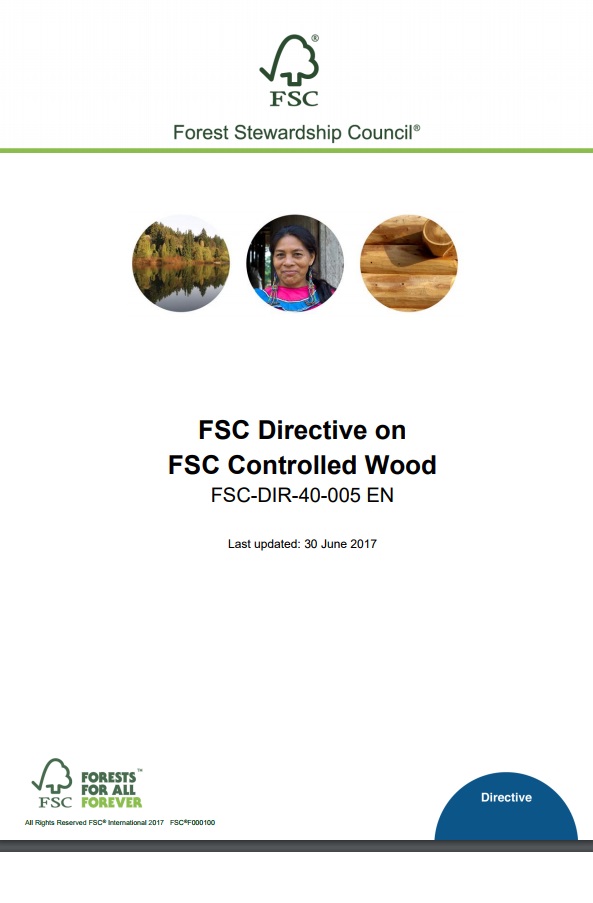FSC Controlled Wood requirements updated to better comply with the EU Timber Regulation
FSC changed its requirements on the use of risk assessments for illegally harvested wood for sourcing Controlled Wood on 30 June 2017. This article describes what has changed and why.
The changes affect you if:
- You source Controlled Wood and are certified using version 2-1 or 3-1 of the Standard AND
- You source Controlled Wood from Australia, Argentina, Belgium, Brazil, Bulgaria, Czech Republic, Chile, Denmark, Germany, Italy, Japan, New Zealand, Poland, Portugal, Romania, Russia, Spain, Ukraine or the United Kingdom.
Why have the Controlled Wood requirements been changed again?
FSC updated the requirements for Controlled Wood so that they better meet the requirements of the EU Timber Regulation (EUTR). This is a change that we called upon FSC to implement in the position paper we published last year.
In March 2017, FSC published version 3-1 of its Controlled Wood Standard (FSC-STD-40-005 V3-1). The main change that was made was to require companies that wish to demonstrate compliance with the EUTR to use a new FSC risk assessment [1] for category 1 (on legality), rather than an old risk assessment [2]. Our article explains more about the changes that were made.
However, despite these changes, products with an FSC Mix claim still might not meet EUTR legality requirements. The problem is that a certified company knows if they are using a new FSC risk assessment or not, but may not know whether all the companies upstream of them in the supply chain have also used a new risk assessment. This is particularly true for companies with long or complex supply chains.
This latest update to the Controlled Wood requirements addresses that shortcoming.
What has been changed?
FSC has made it mandatory for all companies to use a new FSC risk assessment for category 1 (on legality), rather than an old risk assessment. Before, only companies wishing to demonstrate compliance with the EU Timber Regulation had to do this; now all companies have to.

Do the changes affect me?
The changes affect you if you source Controlled Wood from a country with an old national risk assessment. These countries are:
- Australia
- Argentina
- Belgium
- Brazil
- Bulgaria
- Czech Republic
- Chile
- Denmark
- Germany
- Italy
- Japan
- New Zealand
- Poland
- Portugal
- Romania
- Russia
- Spain
- Ukraine
- United Kingdom.
This applies whether you are certified under version 2-1 or 3-1 of the Controlled Wood Standard.
If you are not sourcing timber from one of the countries listed above, you do not need to do anything.
What do I need to do?
Step 1: If you are sourcing from one of the countries listed above, you must ensure that your Controlled Wood verification programme (version 2-1) or due diligence system (version 3-1) is updated so that it refers to and uses the new risk assessment for Controlled Wood category 1. These risk assessments are available to download from FSC’s ‘Document Centre’.
Step 2: What you need to do depends on the country you are sourcing from, and the version of the Controlled Wood Standard that you are using, as described in the table below.
| Countries this applies to (at the time of writing) | Risk conclusion in the old risk assessment | Risk conclusion in the new risk assessment | What you need to do |
| Australia (all species other than sandalwood), Belgium, Denmark, Germany, Japan, New Zealand, Portugal and the United Kingdom. | Low risk of illegality | Low risk of illegality | Nothing else. |
| Argentina, Brazil, Bulgaria, Chile, Italy, Romania, Russia and Ukraine. | Non-low risk of illegality (which FSC refers to as an ‘unspecified risk’) | Non-low risk of illegality (which FSC refers to as a ‘specified risk’) | Standard version 2-1: Continue to implement your verification programme and update it because the specific risks listed will have changed.
Standard version 3-1: Update your risk mitigation because the specific risks listed will have changed. |
| Czech Republic, Poland, Spain, and sandalwood from Australia. | Low risk of illegality | Non-low risk of illegality (which FSC refers to as a ‘specified risk’) | Standard version 2-1: Begin implementing a verification programme (Annex 3 of the Standard).
Standard version 3-1: Begin implementing risk mitigation (Section 4 of the Standard) |
How long do I have to comply with these changes?
If you are certified to version 2-1 of the standard, you need to use the new risk assessments by 30 September 2017.
If you are certified to version 3-1 of the standard, you need to use the new risk assessments:
- By 18 November 2017 if you are sourcing from Belgium or Denmark. This is because the old national risk assessments for Belgium and Denmark were replaced by centralised national risk assessments on 18 May 2017, and companies have six months in which to start using them.
- By 31 December 2017 for all other countries.
Where can I find more information?
The new requirements are contained in an updated version of the Directive on Controlled Wood (FSC-DIR-40-005). In this Directive, there is
- a new advice note (ADVICE-40-005-21) that refers to V3-1 of the Controlled Wood standard (FSC-STD-40-005), and
- an updated version of an advice note (ADVICE-40-005-19) that refers to V2-1 of the Controlled Wood Standard
All FSC risk assessments are contained in FSC’s ‘Document Centre’. The page for each country’s risk assessment explicitly states what shall be used.
For more information about Controlled Wood, see:
- Our article that explains how Controlled Wood version 3-1 differs from version 3-0.
- Our article on our experiences carrying out a Controlled Wood audit with Stora Enso Wood Supply Russia.
[1] A ‘new’ National Risk Assessment is one developed according to FSC-PRO-60-002 V3-0
[2] An ‘old’ National Risk Assessment is one developed according to FSC-PRO-60-002 V2-0



